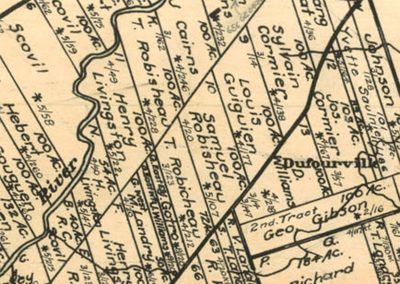Dufourville
Thirty years before this historical village was named Dufourville, settlers had started arriving in the area. By the early 1900s, the village had a school and a post office to serve its growing population. Early settlers included Samuel Robichaud, Louis Guéguen, Jos Cormier, Yvette Saulnier, and Sylvain Cormier. The settlement was named in honour of Father Paul Dufour who served as parish priest from 1897 to 1913. It serves as a reminder of his many accomplishments and great contribution to the parish.
The hamlet of Dufourville stretches along route 115, one km past the Catholic church heading towards Moncton on route 115 and includes Melanson Road, Saulnier Road, and Line Road. And in this area was located Suretteville and Village des Pishcots.
At the Kent-Westmorland County line is where Dufourville ends and where LeBlancville begins. Its name honours Père Paul Dufour and serves as a reminder of his many accomplishments. Among these great contributions was the creation of a catholic parish known as Paroisse Notre-Dame-du-Sacré-Coeur.
Father Paul Dufour arrived in Notre-Dame in September 1897 at the age of thirty-four. During this time, the community was thriving and growing quickly. In 1907, he traveled to Europe and Palestine and was worldly. After serving the parish for sixteen years, Father Dufour left in October 1913.
Paul Dufour was born in Madawaska, Maine, in 1864 in the parish of St David, ME. He studied at Collège Saint-Joseph (Memramcook, NB) and at the Gd. Séminaire de Québec. He was ordained priest in 1891 at the age of twenty-seven.
His mother was Eleonore Marie Thibodeau Dufour, born in 1824 and died May 4, 1872. His father was Narcisse Dufour, born September 15, 1815, and died March 15, 1897. His paternal grandparents David Joseph Dufour and Charlotte Pothier Dufour came from Saint Louis-de-Kamouraska, QC and they died in Saint Basile, NB.
Father Paul Dufour died January 30, 1938, in Montréal, QC, at the age of seventy-four. He is buried in Saint Joseph Cemetery in Old Town, Penebscot, Maine.
Abt 1841
The first school built was a log cabin used to teach children of the first settlers. It was located across the road from present day Notre-Dame Express store. The small school would be replaced in 1906 with a new two room school built one mile down the road, towards the mill.
1851 to 1875
1857
On April 14, 1857, Olivier and Annie Robichaud purchased land in Dufourville from Samuel and Marie Robichaud. They settled and were soon followed by Vital Landry.
1861
Construction of a Catholic chapel began in Dufourville. Unfortunately, it was destroyed by a strong wind before being completed. Mass was therefore celebrated in a private home until a new church was built in 1866. Abbé Antoine Gosselin, from Cocagne Parish, was the visiting priest from 1855-1862.
Abt 1866
A small 40 by 30-foot church was built nearby where the chapel had been destroyed five years earlier. The construction was overseen by Father J.M. Vanier, assistant to Abbé Gosselin who was the second resident priest of Cocagne and served there until 1875. Previously, the community had been a mission of Cocagne which was served by missionaries from Gédaïc (Shediac) until 1842 when the mission was reorganised and became a mission of Bouctouche. In 1862, Abbé Henri Berthe became the first resident priest in Cocagne. He was succeeded by Abbé Gosselin in 1863.
1876 to 1900
1890’s
Brothers Philippe and Félicien Bourque operated a sandstone quarry in Dufourville and the Bourque Quarry employed fifteen to twenty men. The new Bouctouche-Moncton rail line, with stops along the way, greatly helped in the economic development of the area and accommodated shipment of heavy materials such as stone.
A second quarry, the Stevens Quarry, was owned by Edgar Stevens. According to an 1890 newspaper (L’Évangeline) article, the quarry had “recently” received $1200 stone order for a building in Moncton (the now-demolished YMCA building). The Stevens Quarry was located just south of the railway bridge in Notre-Dame. A rail branch line was added to transport quarry stones. In 1895, Thomas Dobson was the quarry operator and he remained so until 1898.
Both quarries were closed by 1912. The stones from the Stevens Quarry were used to build the church l’Église Saint-Antoine de l’Hermite (1923), in neighbouring St-Antoine. Residents from Notre-Dame and St-Antoine teamed up to transport the stones to the church site since the quarry had been closed.
Meanwhile, Henri LeBlanc operated a flat rock quarry in Suretteville. His two sons, Arthur and Adélard, continued the operation for several years.
Note: There is a conflicting information regarding the source of stones used to build the Saint Bernard Church (Botsford Street at Gordon, Moncton – 1887 to 1891) and Mary’s Home (Mountain Road at Bonaccord, Moncton – 1908). These buildings were not built with stones from the Stevens Quarry in Notre-Dame. According to “Industrial Minerals Summary Data”, issued by NB Department of Natural Resources, in both cases the stones originated from the McSweeney Quarry located in Scotch Settlement. This quarry was owned by Edward McSweeney, a former Moncton mayor.
1893
In July, Guilford P. Goguen paid Joachim P. Goguen $1.20 for 2 lbs of tobacco according to a worker’s diary.
1893
Work records showed Charles Noel, Maxime Gallant, David Chapman, and Philip A. Goguen as having worked on the bridge over the Cocagne River in Notre-Dame.
1894
On May 30, 1894, Philip Goguen exchanged $4.25 worth of potatoes and bought two sheep from Maximin Babineau for $2.50 as noted in a record of household affairs.
1895
On June 10, 1895, Maximin Babineau bought one pair of oxen for $40 as noted in a record of household affairs.
1896
In June 1896, Edward White hired several men to work: Fred Barnes, Thomas Scott, John Cochran, Silvain Goguen, Maxime Goguen, and Philip A. Goguen.
1897
On October 9, 1897, Ferdinand Léger bought 12m of shingles for $12 as noted in a record of household affairs.
1897
Father Paul Dufour arrived in Notre-Dame in September 1897 to serve as the community’s second resident priest. He was thirty-four years old, and a time when the community was bustling and growing quickly. In 1907, he traveled to Europe and Palestine. After serving the parish for sixteen years, Father Dufour left in October 1913.
Paul Dufour was born in Madawaska, Maine, in 1864 in the parish of St David, ME. He studied at Collège Saint-Joseph (Memramcook, NB) and at the Gd. Séminaire de Québec. He was ordained in 1891 at the age of twenty-seven.
His mother was Eleonore Marie Thibodeau Dufour, born in 1824 and died May 4, 1872. His father was Narcisse Dufour, born September 15, 1815, and died March 15, 1897. His paternal grandparents David Joseph Dufour and Charlotte Pothier Dufour came from Saint Louis-de-Kamouraska, QC and they died in Saint Basile, NB.
Father Paul Dufour died January 30, 1938, in Montréal, QC. He is buried in Saint Joseph Cemetery in Old Town, Penebscot, Maine.
The hamlet of Dufourville was named in honour of Père Dufour and it serves as a reminder of his many accomplishments and great contribution to the parish.
1897
A residence for the priest was built next to the Catholic Church.
1900 to 1925
1900
One-half ton of hay cost $3.50, one bushel grass seed $2.50, one pair of shoes $1.10, five locks and nobs $1.50, one bottle of Mother Seigel $0.30, one hundred lbs of flour $5, three lbs of tea $1.20, one gallon of oil $0.25, and one bottle of liniment $0.35 according to a record of household affairs.
1901
The Catholic Church was officially named Notre-Dame-du-Sacré-Coeur and the parish subsequently defined the territory of the community of Notre-Dame. The hamlets (or historical villages) included were MacDougall Settlement, Poirier Office, LeBlancville, Dufourville, Notre-Dame Centre, Guéguen, Hays, Alexandrina-Nor’ouest, North and South sides of the river, Whites Settlement along with Village des Pishcots, Village des Fricots, Suretteville, Teed Road and Chemin des Thaddées.
Note : In the 1900s, teachers were hired by local parent committees. The teachers were “housed and fed” around the school. Inspectors, hired by Dundas Parish administrators, visited the school regularly and wrote detailed reports that would influence and bring about change.
1907
Parish Priest, Père Paul Dufour, traveled to Europe and Palestine.
1913
A post office opened in Dufourville. For many years, Dominique Robichaud was postmaster. It closed in 1956.
1925 to 2000
1946
A new school was built in Dufourville and it remained open until about 1966.
1954/56
A home postal delivery service was introduced in Notre-Dame. Mail was delivered by drivers who would insert letters and parcels in mailboxes next to the road of each house and business throughout the community. One route started at the Notre-Dame Post Office then onward to Hays, Alexandrina-Nor’ouest, across the covered bridges to Poirier Office, LeBlancville, Dufourville and ending where the route began, at the post office. Delivery areas grew to include Guéguen, the South side of the river road. The MacDougall Settlement mail delivery was and remains part of a different route.
With the arrival of mailboxes and home postal delivery, several small post offices were closed, such as Dufourville, LeBlancville, Alexandrina-Nor’ouest, Poirier Office, and MacDougall Settlement.
Postal delivery was first done and for many years by Joe Delaney, followed by Thomas Robichaud, M. Delaney, Olivier Bourque, Alcide Pellerin, Frank Maillet, Regis Bourque, and others.
1958
The Notre-Dame community was made up of different school districts: Upper Guéguen, Hays, Alexandrina, LeBlancville, Dufourville, MacDougall Settlement, Whites Settlement (joined with Cocagne around 1965) and Notre-Dame Centre. The school board was responsible for maintaining and repairing schools as well as hiring teachers, heating, and other expenses, paid for by local taxes.
1959
On January 14, 1959, the two-room wooden school, Dundas School, was destroyed by fire. Classes start again in the parish hall and in the basement of the church. Only ten months later, a new two-story brick school was officially opened on November 14. École Centrale de Notre-Dame continues to serve French-speaking students from across the community. Today, it is known as École Notre-Dame. The first director was Roméo Robichaud, followed by Gérald Aucoin who stayed there for many years and accomplished a lot. The president of the school board was Ernest Gallant. Ernest and Gérald worked a lot together.
1966
The school at LeBlancville closed. Shortly afterwards, the school at Dufourville also closed.
2000
In March, the postal addresses were changed from site and box number to civic numbers thereby improving efficiently and visibility, especially for emergency services such as fire and balance services.


